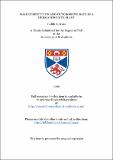Files in this item
Male competition and outcrossing rate in a hermaphrodite plant
Item metadata
| dc.contributor.advisor | Abbott, Richard J. | |
| dc.contributor.author | Irwin, Judith Ann | |
| dc.coverage.spatial | 200 p. | en_US |
| dc.date.accessioned | 2018-06-21T12:57:38Z | |
| dc.date.available | 2018-06-21T12:57:38Z | |
| dc.date.issued | 1990 | |
| dc.identifier.uri | https://hdl.handle.net/10023/14400 | |
| dc.description.abstract | The principal aim of the research presented in this thesis was to investigate factors affecting the "male competition" component of sexual selection in the hermaphroditic species, Senecio vulgaris. As male reproductive function consists of attracting pollinators and the success of pollen in contributing genes to the next generation, sexual selection will act on both the sporophytic and gametophytic stages of the life cycle. The potential for, and consequences of male competition were analysed at both pre- and post-pollination stages. A comparison of the relative attractiveness of the radiate and non-radiate morphs of S.vulgaris to pollinators revealed that in mixed stands, pollinators discriminated in favour of the radiate morph irrespective of the frequency of the two morphs in a population. Measurement of intramorph and intermorph maternal outcrossing rates showed the radiate morph always outcrossed at higher levels than the non-radiate morph. Both morphs exhibited levels of male outcrossing, the radiate morph exhibited higher levels of intramorph paternal outcrossing while non-radiate pollen was more successful than radiate pollen in intermorph crosses. The potential levels of intermorph and intramorph pollen competition experienced by the radiate and non-radiate pollen types suggest radiate pollen was subjected to greater levels of competition for access to ovules than non-radiate pollen. Examination of post-pollination events suggested that radiate pollen germinates faster than non-radiate pollen when applied to stigmas of either morph. However, no consistent evidence of radiate pollen tubes outcompeting non-radiate pollen tubes in the style and consequently fertilising a disproportionate share of available ovules was obtained. The problems associated with measuring pollen competitive ability are discussed. In addition to the research on male competition, a study was also conducted to examine the origin of the radiate morph of S.vulgaris. Morphometric and electrophoretic analyses provided strong evidence that a radiate variant from York possessed more 'squalidus-like' characters than are generally found in radiate S.vulgaris. It is suggested that this radiate form may represent an early stage in the origin of radiate S.vulgaris via introgression of S.squalidus into S.vulgaris. | en_US |
| dc.language.iso | en | en_US |
| dc.publisher | University of St Andrews | |
| dc.subject.lcc | QK826.I8 | en |
| dc.subject.lcsh | Plant physiology | en |
| dc.title | Male competition and outcrossing rate in a hermaphrodite plant | en_US |
| dc.type | Thesis | en_US |
| dc.contributor.sponsor | Natural Environment Research Council (NERC) | en_US |
| dc.type.qualificationlevel | Doctoral | en_US |
| dc.type.qualificationname | PhD Doctor of Philosophy | en_US |
| dc.publisher.institution | The University of St Andrews | en_US |
This item appears in the following Collection(s)
Items in the St Andrews Research Repository are protected by copyright, with all rights reserved, unless otherwise indicated.

